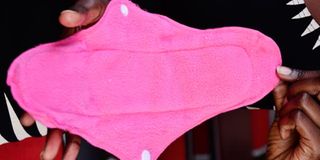Prime
Reusable sanitary pads: Wash, dry and reuse

A reusable sanitary pads with flaps and fasteners at the side. With access to these, many girls would not absent themselves from school during menstruation . PHOTO BY ALEX ESAGALA
What you need to know:
- For girls and women who cannot afford the comfortable pads available on the market, there are reusable sanitary pads. Here are the reasons why they are a better option.
- The studies indicate that more than half of Ugandan girls drop out before sitting for their primary school-leaving examinations.
Bernice Apio was 14 years old when she started menstruation, a normal blood discharge that is part of a woman’s monthly cycle.
Frightened, Apio ran to tell her mother to explain about the blood stains she found in her knickers.
Her mother reacted by getting some clean pieces of cotton cloth and rolling them into some sort of pad. She then instructed Apio to wear the pad every time there was this discharge. After a designated number of hours, she should change into a clean one and wash the one she was previously wearing before hanging it to dry.
Apio has now been using these cloth pads for five years now. “It is what mummy can afford for me,” she says. “There are comfortable pads on the market but they are expensive.” Her mother is a farm labourer in Kumi District.
Like many others
Apio is not alone. She is just one of the many girls who rely on reusesable cloth pads during menstruation.
Joy Akol, a senior lady at a girls’ schools in Kumi District says she always advises many girls to make their own cloth pads and not burdening their parents who struggle to make ends meet for their families. So, sanitary pads would not be high on the priority list.
“Since they are individually made, one does not require any money to buy pads,” she says.
A packet of disposable sanitary pads costs an average of Shs3,500. Some women use up to two packets in a month, hence spending Shs7,000. In a year therefore, someone will spend about Shs84,000 on pads alone. But not all girls and women especially in the rural areas can afford such an amount of money, hence resorting to using homemade alternatives.
But the good news is that one can actually access improved reusable sanitary pads which are readily available in the market.
Reddy Reddappa, the marketing manager, Relief Line Uganda, says these are designed in a shape that suits the underwear and are provided with cushioned padding for comfort. “Anyone using a reusable cloth pad will only feel like she is wearing a slightly thicker pad of underwear,” he says.
Advantages
Relief Line Uganda makes reusable sanitary pads for women. They come with lock-in buttons which fasten the flaps to the underwear.
As regards the advantages of reusable pads have, Reddappa says unlike the disposable pads that are discarded immediately after use, reusable pads can be disposed after a period of six months. “This will result in reduction of waste generation. Also, there would be considerable saving on that amount,” he says.
Secondly, because these pads are reusable, they are environmental friendly as there are no incidents of clogging of sewers and no pollution on burning as is possible in the case of disposable pads.
It is estimated that billions of pads and tampons are put into the landfill every year. This is having a serious effect on the environment especially because traditional pads are packed in polythene and take many years to break down. Noteworthy, many of these pads are finding their way into seas and rivers, hence, causing severe problems for marine life.
Disposal issues
Then, there are cleaners whose job involves picking up and throwing away the used disposable pads that are left behind in toilets. One can only imagine the health risks these workers are subjected to on a daily basis.
One toilet cleaner Daily Monitor interviewed says in the facility she works, the sanitation is nauseating as on many occasions, she finds unwrapped sanitary pads left dumped at the corners of the lavatory.
Sometimes she is left with no choice than use her hands to pick them up, hence exposing her health into more risk.
For girls in rural schools, Reddappa believes that reusable pads will reduce the gender-specific barrier and improve girl attendance and retention rates in primary schools.
This means that thousands of girls will now have a product that allows them to manage their period effectively and hygienically. “Girls should be empowered to achieve their full academic potential by improving attendance rates at least by as much as 25 per cent,” he says.
A study on menstrual management in Uganda funded by Austrian Development Cooperation, which was carried out in seven districts— Arua, Adjumani, Budibugyo, Kasese, Kyenjojo, Lira and Soroti—states modern sanitary pads are available but only affordable for the middle and upper class.
The studies indicate that more than half of Ugandan girls drop out before sitting for their primary school-leaving examinations. The fact that girls, between the ages of 11 and 13, are dropping out has potentially been linked to the beginning of the menstruation cycle and its associated challenges.
Take note
This is what to bear in mind while using reusable sanitary pads. Always carry a bag to hold the fresh and used ones. After removing the used cloth pad, fold and put inside a neat little package that can be slipped into the bag. Once home, remove the used pad, wash and hang to dry.




